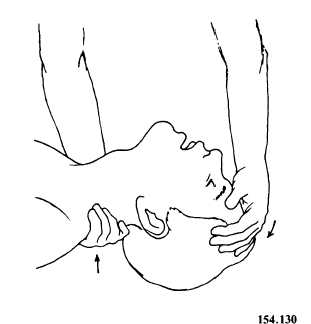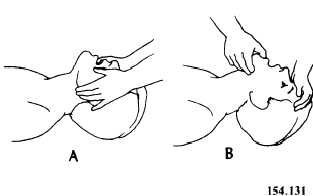Opening the Airway Many problems of airway obstruction, particularly those caused by the tongue, can be corrected simply by repositioning the head and neck. If repositioning does not alleviate the problem, more aggressive measures must be taken. NOTE: Before going further, it is imperative that corpsmen remember to check all victims for possible spinal injuries before any repositioning is attempted. If there is no time to immobilize these injuries and the airway cannot be opened with the victim in the present position, then great care must be taken when repositioning. The head, neck, and back must be moved as a single unit. To do this, adhere to the following steps (see figure 4-2).

Figure 4-3.—Head tilt.
Head Tilt
The head tilt technique of opening the airway is a simple repositioning of the head. With the patient lying down, place one of your hands on his or her forehead and apply gentle, firm, backward pressure using the palm of your hand. With your other hand under the victim’s neck, lift the neck (fig. 4-3). This will lift the patient’s tongue away from the back of the throat and provide an adequate airway. NOTE: This technique is not recommended for patients with suspected neck or spinal injuries.

Figure 4-4.—Jaw thrust.
Jaw thrust
A second technique for opening the airway is the jaw thrust. This technique is accomplished by kneeling by the top of the victim’s head and placing your fingers behind the angles of the lower jaw (fig. 4-4A), or hooking your fingers under the jaw (fig. 4-4B), then bringing the jaw forward. Separate the lips with your thumbs to allow breathing through the mouth as well as the nose. This technique is to be used if a neck injury is suspected.
Either the head tilt or the jaw thrust will offer some relief for most forms of airway obstruction. They also prepare the airway for artificial ventilation. If the airway is still seriously obstructed, it may be necessary to try to remove the obstruction by using the abdominal thrust or chest thrust methods indicated for opening a completely blocked airway.
